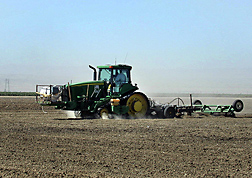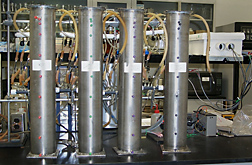Into Thin Air
A simpler way to track pesticide
emissions from agricultural fields
It’s hard to find fault with strawberries. These popular, ruby-red gems are a fine source of vitamin C, folate, and ellagic acid, a possible cancer preventive. In California, where 80 percent of the nation’s crop is grown, they’re also a major industry—worth more than $1.2 billion.
Unfortunately, strawberries—in addition to tomatoes, peppers, grapes, carrots, almonds, and other consumer favorites—often require use of potent fumigants before planting to control soil-dwelling pests, such as nematodes, fungi, and weeds. But because of an impending prohibition against the widely used methyl bromide and new, more stringent ambient air quality standards currently being implemented by the U.S. Environmental Protection Agency (EPA), growers are under pressure to reduce their pesticide emissions.
These emissions—made up in part of volatile organic compounds, or VOCs—are a growing public health and environmental concern. Generated from a variety of industrial, urban, and rural sources, VOC’s can contribute to smog, induce respiratory problems, and accelerate global warming.
Responding to the new air-quality standards, the California Strawberry Commission last year awarded several scientists—including ARS’s Scott Yates—funds to help growers find research-proven tools for reducing fumigant emissions. Yates, who is a research leader at the agency’s U.S. Salinity Laboratory (USSL) in Riverside, California, is still finishing up his study. But based on his findings so far and those gleaned from previous work, he’s confident that the key to getting emissions-reducing technologies into the hands of growers lies in doing the right math and modeling.
Keeping Them in Their Place
Yates, his USSL colleagues, and other scientists have investigated several tactics for limiting the escape of fumigant gases. These methods include draping impermeable plastic films over fields, injecting fumigants up to 2 feet deep into the soil, and adding harmless chemicals and organic matter that can help speed up degradation of fumigants at the soil’s surface.
“In a recent study, we’ve confirmed how something as low-cost as irrigation water, applied soon after fumigant application, can impede volatilization,” says Yates.
All the approaches that Yates and other researchers are evaluating have one goal in mind: to trap fumigants within the soil for as long as possible. Once these chemicals begin their ascent into the air, there’s the potential for human health and environmental consequences.
Despite these promising practices for containing fumigant gases, much experimental data is still needed before state regulators can approve their use by growers.
Adding to this burden is the current standard for gathering such information: expensive, long-term field studies. “Unfortunately,” says Yates, “each of these studies can take up to a year to complete, cost hundreds of thousands of dollars, and, in the process, bring research teams in contact with toxic chemicals.”
And from a scientific standpoint, individual field study results are like snapshots of information in time, says Yates. Each study site is a one-of-a-kind collage pieced together from various geographic, climatic, and cultural practice-related elements. That’s why Yates argues against extrapolating emissions data gathered from a single locale to an entire region—and for repeatable verifications done in the laboratory.
Enlightenment in the Lab
Several years ago, Yates started exploring the potential for simple, low-cost laboratory tests and mathematical models to evaluate—and even predict—fumigant emissions. He and his USSL colleagues have shown, time and time again, that when seeking certain types of volatilization data, the lab can yield the same results as those painstakingly obtained from complex field studies. He’s shown this to be the case with methyl bromide, Telone (1, 3-dichloropropene), and other pesticides.
For instance, in 2005, Yates and colleagues investigated Telone, which is used to fumigate fields before planting carrots. In the field study, they examined the effectiveness of creating surface water “seals” to help reduce the chemical’s escape into the atmosphere. Then they ran a simulated study in their lab, using sophisticated soil columns and gas chromatography to determine how much of the Telone volatilized, despite protective measures. The results? The same as those they’d gotten from their field trials.
Yates quickly notes that field studies will always be needed as a means of tying lab-based findings to real-world agricultural landscapes. Also, laboratory methods cannot provide certain emissions data that are inextricably linked to units of time and prevailing weather conditions and agricultural practices. For instance, emission events contributing to “acute toxicity”—the harm resulting from a short-time exposure to a fumigant—are usually associated with quick, burstlike types of emissions and are best determined in the field.
On the other hand, the laboratory is ideally suited for answering questions like: What is the total fraction of a given fumigant that ends up leaving the soil after it’s been applied? Known as “cumulative emissions,” this measurement is one of the EPA’s critical data requirements and one that Yates routinely evaluates.
Yates hopes to further strengthen his already compelling case for the usefulness and validity of lab studies as he wraps up the strawberry work. He’s now comparing findings from field studies in Oxnard and Santa Maria, California, done by a university group, to findings he gathers in the laboratory. He’ll use the elaborate soil columns and soil cell equipment he’s designed for observing pesticide movement through soil—plus a multitude of mathematically driven models.
The current workload is immense for regulators who are evaluating various emissions-lowering fumigation methods. “With methyl bromide being phased out, we’ve got several fumigants being looked at right now,” says Yates. “Each will require its own set of regulations. Multiply that by a half-dozen potential emission-reduction methodologies, each requiring evaluation, plus other factors, like variations in soil and environmental conditions—and you’re talking about needing to do 40 to 50, or even 60 costly, long-term field experiments.”
Instead of requiring decades, Yates’s methods could greatly increase the efficiency of bringing environmentally sustainable methyl bromide replacements to the growers who need them.—By Erin K. Peabody, Agricultural Research Service Information Staff.
This research is part of Air Quality, an ARS national program (#203) described on the World Wide Web at www.nps.ars.usda.gov.
Scott R. Yates is research leader of the USDA-ARS Contaminant Fate and Transport Unit, U.S. Salinity Laboratory, 450 W. Big Springs Rd., Riverside, CA 92507; phone (951) 369-4803, fax (951) 342-4964.
"Into Thin Air" was published in the October 2007 issue of Agricultural Research magazine.









